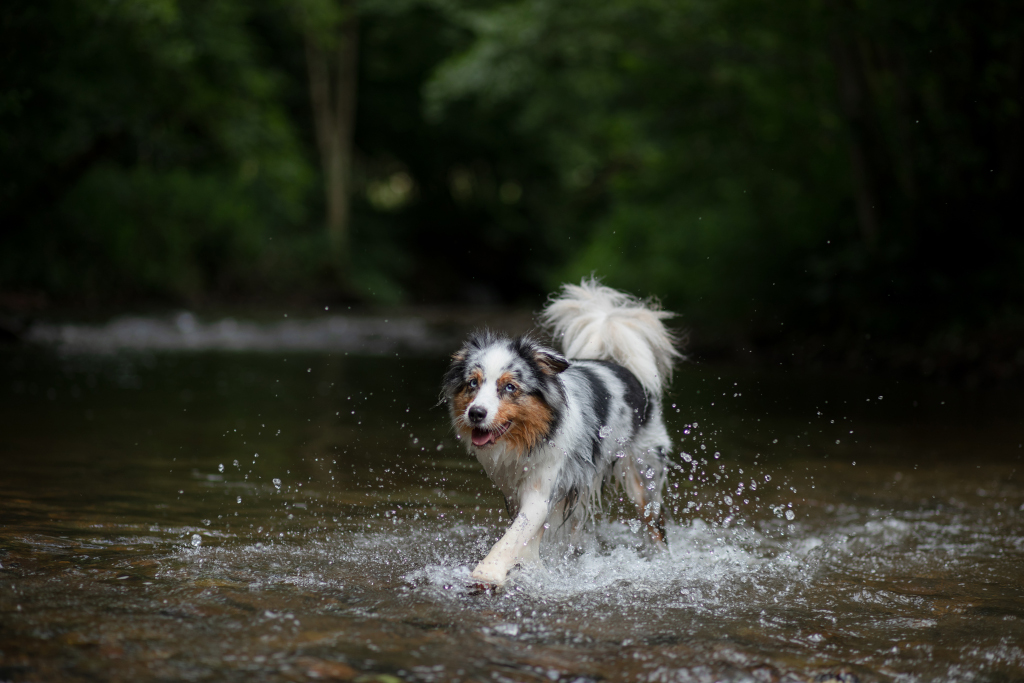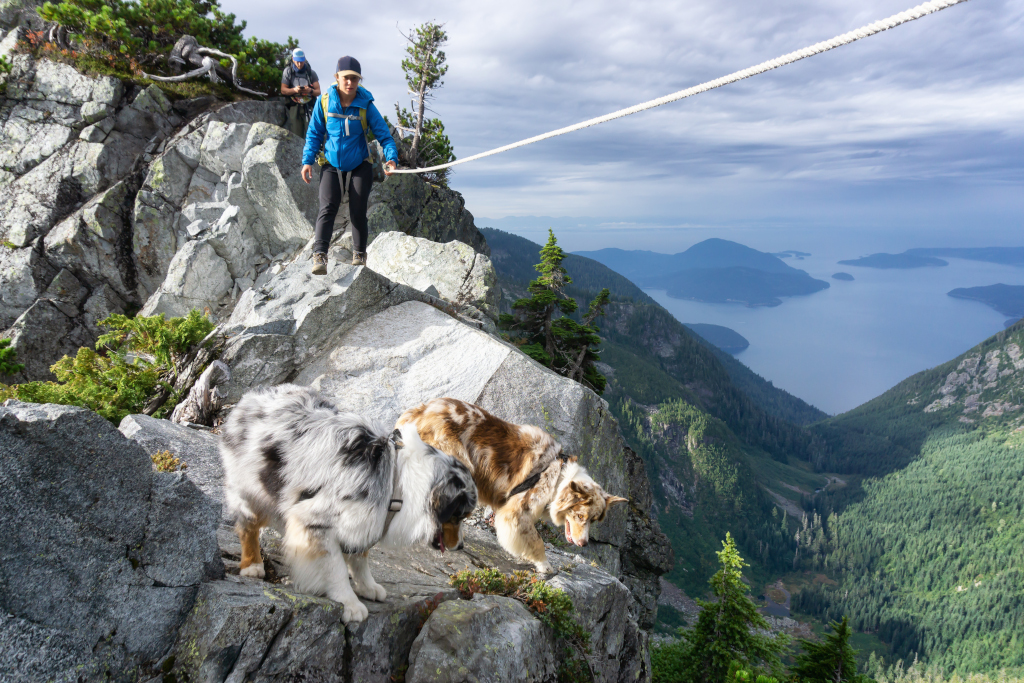Whether it’s a long-distance trek or just a short hike, spending time with dogs in nature is an essential part of many dog owners’ daily or weekly routine.
But being in the great outdoors comes with its own risks.
There are several dangers you’ll need to be aware of before going hiking with dogs, from common hazards like broken glass and rain-swollen creeks to more serious threats like mountain lions and ticks.
Below are the ten common trail dangers you need to know and keep in mind so that you’re better prepared to deal with them should these problems arise.
Read More: Can Small Dogs Trek Long Distances
1. Water Crossings

You’re out walking around with your dog, enjoying the scenery and fresh air, then you notice a small creek up ahead. The chances are that your pup will want to go check it out, as many dogs enjoy splashing through bodies of water, especially after a long day hike.
There’s nothing wrong with this, but when dogs encounter bodies of water on the trail, they’re usually not prepared for just how strong that current can be.
It may be unfounded fears, but dogs can get swept up and pulled downstream by fast-moving currents and rapidly rising water levels after storms or during periods of high runoff when trying to cross a stream or river. Even if your dog could make it to the other side, they could easily injure their paws on sharp rocks that are often hidden by rapidly rushing water.
So if you encounter a waterway while hiking with your furry best friend, it’s probably best to look around for a different point of crossing or carry them in arms or a pet carrier backpack when trying to cross it.
2. Mountain Lions, Bears, Coyotes, and Other Predators
No one wants to think about mauling injuries when they’re taking their dogs for an innocent stroll through the woods, but large predators like cougars do live in many parts of the country. However, you should be more concerned about encountering this type of animal if you’re hiking in certain places, particularly in the west of North America.
Mountain lions aren’t the only type of predators you have to worry about while out in nature. Black bears and grizzly bears are also common in North America, and smaller predators like coyotes can be found throughout the United States, spreading across most parts of the country.
Either way, it’s a good idea to know what predators live in the area you’re hiking in and ensure that your pup is under control at all times. That means keeping them leashed when you’re not sure of what could potentially be lurking in the bushes.
The last thing you want is your furkid running off and getting attacked by wild animals if they get spooked or sense an impending threat.
Read More: Bear Encounter While Camping & Hiking With Dogs: What To Do?
3. Poison Oak, Poison Ivy, Poisonous Mushrooms, and Other Dangerous Plants
When you’re hiking through meadows, forests, and other natural landscapes with your dog, it’s easy to let your guard down and take in the sights without giving a thought to what might be hiding among the trees or growing right out of the ground.
While most of them are harmless, some are highly poisonous to dogs, namely poison oak, poison ivy, and other members of the Toxicodendron family, including poison sumac.
There are other plants you need to look out for as well, like foxtails. These particularly troublesome plants have barbed, needle-shaped seeds that can work their way into a dog’s skin, where they can cause itchy rashes and infections and may even lead to death if left untreated.
You will also find poisonous mushrooms in the wild. Some of them have severe consequences if ingested, especially Amanita phalloides, also known as the death cap, said to be the deadliest mushroom in the world.
So before taking your pooch out on a hike, be sure to do some research about what plants and mushrooms might have on the trail and learn how to identify them. If you spot any, it’s best to give them a wide berth or steer clear of the area entirely.
4. Ticks and Fleas

Luckily, you probably won’t run into any bears or mountain lions while hiking on a well-traveled path through the woods. More likely, your biggest concern will be ticks and fleas.
These tiny pests can latch on to your canine while walking through tall grass, brush, or wooded areas with overgrown foliage and feed on your dog’s blood when they’ve settled into a comfortable spot, like the eyelids, in and around the ears, groin area, under the collar or harness, or between the toes.
These little critters can cause many problems, from skin irritation to diseases like Lyme Disease, Canine Ehrlichiosis, Canine Babesiosis, and Rocky Mountain Spotted Fever (RMSF), which can cause symptoms like fever, loss of appetite, swollen joints, stiffness, etc. And sadly, these diseases can be fatal.
What’s worse, the tick and flea life cycle isn’t just a one-time deal. If you don’t take care of these blood-sucking parasites early on, they can multiply and cause infestations in your pup and home.
So it’s crucial to check your dog for ticks and fleas after your outdoor adventures, whether it’s a short or long trip. If you happen to find one, it’s best to use tick removal tools to extract it, so you don’t leave any mouthparts in the skin. It’s also a good idea to put a tick and flea collar on your dog or apply a monthly topical treatment on your fido’s skin to keep these pests off of them.
Read More: How to Protect Your Pup From Ticks While Hiking
5. Stinging Insects
Apart from ticks and fleas, other biting insects can also pose a problem for dogs while out in the wild. This includes bees, spiders, mosquitoes, yellow jacket wasps, hornets, mites, flies, etc.
You get the gist. When your dog stumbles upon one of these critters while romping through open grass areas or along wooded hiking trails, they may get stung, causing allergic reactions, like swelling and itchiness around the face or muzzle, hives, trouble breathing, or vomiting. And chances are, you won’t be able to brush off the sting and move on with your hike.
To prevent that, you can get an insect repellent collar or spray made specifically for dogs. These products can help keep bugs at bay and prevent them from stinging your pooch.
6. Getting Lost
Your furry hiking partner can get lost while on the trail, and the situation can turn dire very quickly.
And trying to find your pooch in an unfamiliar place can be tricky, if not impossible, without a good sense of direction and a little luck. Plus, you’ll probably be surrounded by lots of dangerous plants and animals in the wild.
So before heading out into the woods with your canine friend, be sure to get them an ID tag with updated information written on it. And it’s also a good idea to invest in a dog collar GPS tracker so you can pinpoint your fido’s location if they ever go missing.
7. Slippery Terrain and Steep Trail Edges

The ground of some parts of the trail can be unsteady, especially when encountering uneven rocks, high steps, and steep drop-offs.
Your dog will be at risk of losing footing when navigating these risky areas and tumble down the cliffside. If they do take a bad spill, the injuries can range from scrapes, bruises, minor fractures, sprains, etc., to serious ones like concussions, broken bones, or even death.
So be sure to watch your dog’s every step and keep them close to you so you can catch them in time if they do slip.
8. Exhaustion
Hiking can be strenuous, especially on long trails full of ups, downs, and challenging terrain.
Plus, the heat of the sun can make your pup thirsty and dehydrated (H2O is life!), so it’s essential to bring plenty of water with you on your hike. And if your dog starts panting hard while you’re out on the trail, don’t push them to keep going. Instead, allow them to rest and have a sip of water.
After all, you’ll need to keep your dog in check, as you wouldn’t want them to fall ill from exhaustion, heatstroke, or dehydration.
9. Heat
There’s no doubt that panting can help dogs cool off on a hot day. But they can still suffer from heat exhaustion and heatstroke if they get too hot after spending too much time in the direct sunlight.
If you notice your dog is panting heavily and showing signs like reddened gums, lethargic, disoriented, or confused, the chances are they’re overheated. If that happens, you’ll need to get them out of the sun immediately and lower their body temperature by giving them fresh drinking water and rinsing them with cool water.
To keep that from happening in the first place, you’ll need to offer your canine companion plenty of water during the trip, take frequent breaks, and avoid hiking at times when the temperature is at its highest. Also, keep in mind that little hiking pups are at a higher risk of getting heatstroke than larger dogs.
10. Cold
Snowshoeing or hiking with your dog in the wintertime can be a lot of fun. But the cold conditions and extreme winds are not only dangerous for you but also for your pooch. They can cause frostbite or hypothermia in your pup and is likely to happen if your canine isn’t wearing appropriate winter gear.
Frostbite and hypothermia are not something you can take lightly. Both conditions can make dogs feel weak, tired, disoriented, shiver, and lower their heart rate. And in severe cases, hypothermia can cause internal organs and respiratory system failure, resulting in death.
So when you’re hiking with your four-legged friend during the winter season, be sure to bundle them up with a cozy dog jacket and snow booties to keep them warm and protect them against the elements.
Read More: How Cold is Too Cold to Go Hiking With Dogs
Conclusion
Hiking with your dog can be an enriching experience that is sure to strengthen your relationship with them. But it’s key to remember that the natural environment is unpredictable at best and dangerous at worst.
Your canine companion should always stay close to you so they don’t wander off and encounter dangerous situations on their own. In other words, you’ll need to keep a close eye on your dog.
In addition, you need to be wary of the cold weather and hot weather, take appropriate precautions to avoid any dangers that stem from these elements, and ensure you have plenty of water available.
And while you probably are not going to come across all of the trail dangers mentioned above on your next hike, it’s imperative to keep these dangers in mind so you can be fully prepared for whatever lies ahead on the trail. After all, preventing trail mishaps is much better than trying to rescue your pup in the midst of one!

